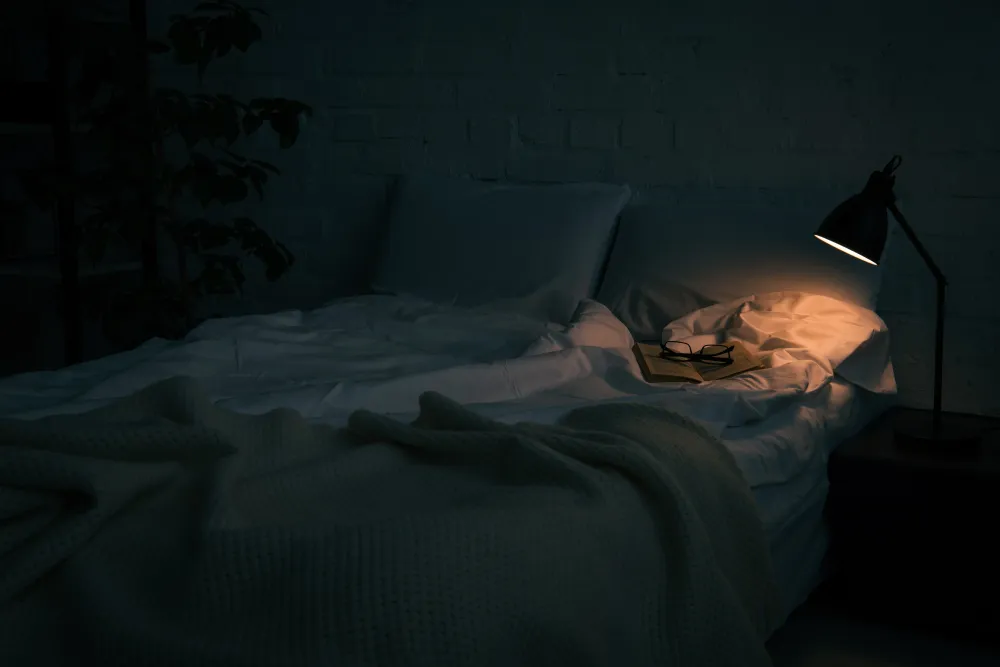Modern life is increasingly plagued by stress, exposure to artificial light, screen overuse, and disrupted circadian rhythms. As a result, sleep disorders and chronic fatigue have become commonplace. But what if the answer lies not just in sleep hygiene, blue-light glasses, or melatonin, but in the very air we breathe?
This article explores the science behind sleep and oxygen, and how Oxyness by Module 21 is helping people finally get the rest they need. We’ll dive into:
🌬️ The biology of sleep and oxygen
💡 Why oxygen levels drop at night (especially in cities)
🔬 Groundbreaking studies on supplemental oxygen during sleep
🛏️ Real-world impacts: from cardiac repair to mood, memory, and gut microbiota
And most importantly, we’ll show how Oxyness supports the four core pillars:
- Freshness: oxygen as pure as in the forest 🌲
- Happiness: more serotonin, less stress 😊
- Effectiveness: deeper REM, higher energy the next day ⚡
- Wellness: long-term cardiac, cognitive, and immune support 🧠❤️
1. Why Oxygen Matters More at Night
When you fall asleep, your breathing changes. Your muscles relax, your body slows down — and so does your ventilation. For individuals with compromised lungs, as well as healthy adults in polluted urban environments, this can result in a subtle yet significant decline in blood oxygen levels during sleep.
According to Robert L. Owens (Respiratory Care, 2013), this phenomenon, known as nocturnal oxygen desaturation (NOD), is common even in individuals who maintain normal oxygen saturation while awake. The consequences? Less regenerative sleep, nighttime awakenings, cardiovascular strain, and daytime fatigue.
🔍 In REM sleep — the most restorative phase — your body reduces breathing depth and frequency. Oxygen delivery becomes even more fragile. Even a drop from 98% to 92% SpO₂ can impact memory consolidation and mood.
📉 Chronic drops below 90% saturation are strongly associated with arrhythmias, nighttime blood pressure spikes, and poor sleep architecture. In people with sleep-disordered breathing, these episodes can occur repeatedly throughout the night.
2. Oxygen and Sleep Deprivation: A New Scientific Link
In 2025, researchers Cai et al. published a groundbreaking study that connected sleep deprivation, heart dysfunction, and gut health. Using a mouse model, they demonstrated:
Sleep-deprived mice suffered from:
- Cardiac fibrosis
- Inflammation in the heart and brain tissue
- Depression-like behaviors
- Disrupted gut microbiota
But when treated in a 30% oxygen environment for two hours daily:
- Cardiac function significantly improved
- Inflammatory cytokines (TNF-α, IL-6) dropped
- Gut microbiota balance was restored
- Transcriptomic analysis revealed reversal of hypoxia-driven genetic changes
The oxygen didn’t just treat symptoms — it addressed the biological root causes of sleep-related damage. This validates the concept that controlled oxygen enrichment during sleep can be a therapeutic tool — not just for patients, but for healthy individuals exposed to chronic stress and poor air quality.
3. The Overlooked Epidemic: Oxygen Drop During REM
While we often blame noise, light, or stress for sleep disturbances, few realize how ventilation naturally drops during sleep. In REM sleep:
- Muscle tone (except for the diaphragm) nearly vanishes
- Tidal volume decreases
- Ventilatory response to CO₂ and O₂ is blunted
According to Owens (2010), this makes even healthy adults susceptible to desaturation in polluted or poorly ventilated environments, especially in cities where indoor air stagnates overnight. For those with borderline daytime oxygen levels (20.1–20.3% O₂), the drop during REM can be clinically significant.
In the most severe cases, NOD contributes to:
- Cardiac arrhythmias
- Nocturnal hypertension
- Sudden cardiac death risk
- Morning headaches and fatigue
Even in less severe forms, it leads to sleep fragmentation, preventing deep, regenerative rest.
4. Oxyness: Smart Oxygen for Restful Sleep 🌿
Oxyness by Module 21 restores the ideal oxygen environment, without the risks of 100% oxygen or clinical hyperbaric therapy. Instead, it maintains a safe, mild oxygen enrichment, which mimics the oxygen content of forest air.
Unlike standard systems:
- ✅ No high-pressure tanks
- ✅ No risk of hypercapnia
- ✅ Designed for daily home use
Oxyness operates silently, enriching your bedroom air while filtering pollutants and balancing humidity. It’s your private forest ecosystem — available every night.
📈 In clients using Oxyness:
- Sleep tracking shows longer REM and deep sleep phases
- Resting heart rate decreases
- Morning alertness improves
Oxyness doesn’t treat disease — it restores physiological balance.
5. Freshness 🌬️ — Your Bedroom Should Breathe
Modern rooms are sealed, insulated, and poorly ventilated. Overnight, CO₂ builds up, oxygen drops, and humidity rises. You wake up with:
- Brain fog
- Fatigue
- Headaches
Oxyness replaces this stale air with filtered, enriched outdoor air — delivering the freshness of a mountain forest, quietly and consistently.
With a controlled oxygen levels, it matches what our biology evolved to breathe.🌲
6. Happiness 😊 — Mood Starts with Oxygen
In the 2007 study by Seo et al. (Psychiatry Investig), healthy adults inhaling 35% oxygen showed:
- Improved verbal memory performance
- EEG (electroencephalogram) patterns associated with calmness (increased alpha, decreased beta/gamma)
Lower beta and gamma frequencies are linked with reduced anxiety. Oxygen doesn’t just help you sleep — it makes you feel better while awake.
Combined with better REM quality, oxygen-enriched sleep enhances mood, serotonin levels, and emotional resilience.
7. Effectiveness ⚡ — Sleep That Powers Your Day
Cai et al. (2025) demonstrated that sleep deprivation impairs mitochondrial function, gut barrier integrity, and cardiac structure. But with 30% oxygen therapy, mice recovered faster — on all levels.
Applied to humans:
- Faster physical recovery
- Better focus and productivity
- Reduced oxidative stress*
*According to Nagatomo (2012), oxygen concentrations exceeding 40% concentration, can increase oxidative stress. “Previous studies have shown that regardless of the pressure, treatment when oxygen concentration exceeds 40% can have a detrimental effect, whereas exposure to mild hyperbaric oxygen at the rather low oxygen concentrations (35–40% oxygen) does not lead to elevated levels of oxidative stress in rats and humans”.
It’s not just sleep — it’s recovery. Oxyness helps your body and brain repair deeply while you rest without any oxidative stress.
8. Wellness 🧘 — The Oxygen-Sleep-Heart-Gut Connection
The gut microbiome is increasingly recognized as a central regulator of whole-body health. It influences:
- 🧠Cognitive function and mood via the gut-brain axis
- ❤️Cardiovascular resilience through microbial metabolites
- 🦠Immunity by modulating cytokines and mucosal defense
However, sleep deprivation throws this ecosystem into disarray. According to Cai et al. (2025), even short-term sleep loss leads to:
- A reduction in microbial diversity
- An imbalance in the Firmicutes/Bacteroidetes ratio, indicating dysbiosis
- An increase in pro-inflammatory bacteria such as Escherichia-Shigella
- A decline in beneficial strains like Faecalibacterium prausnitzii and Lactobacillus spp.
But when oxygen levels were restored during the sleep-deprived period — specifically at 30% oxygen concentration — remarkable physiological changes were observed:
✅ Gut microbiota diversity rebounded, as measured by Chao1 and Shannon index
✅ Populations of beneficial bacteria such as Akkermansia muciniphila increased
✅Short-chain fatty acid (SCFA) production improved, especially butyrate, a key anti-inflammatory metabolite
✅ The gut-heart axis stabilized, with reduced cardiac fibrosis, enhanced mitochondrial function, and improved ejection fraction
While the study used 30% oxygen acutely in a controlled setting, similar benefits can be achieved with continuous exposure to a milder enrichment — such as normal or slightly elevated oxygen levels, the natural level found in pristine forest environments.
This is precisely what Oxyness by Module 21 offers: A safe, continuous, and sustainable enrichment of indoor air, optimized for nighttime recovery and physiological equilibrium.
Where hyperbaric and clinical oxygen therapies use high concentrations for short durations, Oxyness achieves compounding effects through constancy — restoring the indoor environment to the oxygen standard our biology evolved for.
9. Safe, Natural, Sustainable
Unlike clinical oxygen treatments:
- Oxyness uses atmospheric pressure only
- Keeps O₂ at safe levels (of up to a 21.4% oxygen concentration in the bedrooms)
- Avoids oxidative stress risks seen at 40%+
It’s designed for daily, long-term use — safe for children, elders, and even pets. No tanks. No noise. No intervention needed.
10. Final Thought: Sleep Like You’re in the Forest 🌲
You spend one-third of your life asleep. Why not spend it breathing better?
Oxyness by Module 21 turns your bedroom into a micro-ecosystem — quietly restoring your biology every night with:
🟢 Freshness
😊 Happiness
⚡ Effectiveness
🧘 Wellness
Whether you’re biohacking performance, recovering from burnout, or just tired of feeling tired… it all starts with oxygen.
Breathe Better. Live Better. Experience Oxyness
References:
- Owens, R.L. (2013). Supplemental Oxygen Needs During Sleep: Who Benefits? Respiratory Care. Available: https://doi.org/10.4187/respcare.01988
- Cai S., Li Z., Bai J., Ding Y. Liu R., Fang L. (2025). Optimized Oxygen Therapy Improves Sleep Deprivation-Induced Cardiac Dysfunction Through Gut Microbiota. Intestinal Microbiome. Vol. 15. Available: https://www.frontiersin.org/journals/cellular-and-infection-microbiology/articles/10.3389/fcimb.2025.1522431/full
- Seo, H.-J. et al. (2007). The Effect of Oxygen Inhalation on Cognitive Function and EEG in Healthy Adults. Department of Psychiatry, College of Medicine, The Catholic University of Korea. Available: https://www.cpn.or.kr/journal/download_pdf.php?spage=25&volume=5&number=1
- Nagatomo F., Gu N., Fujino H., Okiura T., Morimatsu F., Takeda I. (2010). Effects of exposure to hyperbaric oxygen on oxidative stress in rats with type II collagen-induced arthritis. Clinical and experimental medicine. Vol 10., pp. 7–13. Available: https://link.springer.com/article/10.1007/s10238-009-0064-y
Recent entries:

Module21 for Your Business

Module21 for Your home




